Decision Making Process
Decision Making Process

Aspy and Grossman
The decision making process visual shows that the evaluation professionals gather data through interviews, observations, and formal and informal tests. They then use their clinical judgment to consider if the pattern of autism for educational identification is present.
The process does not stop there. The team also uses the information gathered to make recommendations to address concerns, maximize strengths and resources, and suggest programming strategies for the student. Meaningful, individualized, and specific recommendations are the most important outcome of an autism assessment regardless of the eligibility decisions made.
Examples of Meaningful Individualized Recommendations for School Settings
Dylan would benefit from a staff member who is well trained in working with autistic students and who knows him well accompanying him as a liaison during any disciplinary situation.
Dylan is involved in orchestra and enjoys it. The staff is encouraged to identify 2-3 leaders from Dylan’s orchestra class who could be asked to socially interact with Dylan outside of orchestra. These students would need to be coached in Dylan’s needs and given some strategies they could use during social times such as lunch, group work, passing periods in the hallway.
Use of workstations in the morning may help to “ease” Lamar into the school setting. Workstations will provide Lamar with clear expectations of what work he must complete, how much work remains, and what to do after he is finished. Make sure that designated work areas are clearly labeled and defined and clear the workspace from distractions.
Examples of Meaningful Individualized Recommendations for Multiple Settings
Adults should be made aware that Dylan may need to give his perspective in an area where he disagrees. It is important for the staff members to be able to make a distinction between disrespect and stating his perspective in a respectful way. Dylan will need training in this as well and adults are encouraged to be patient as Dylan develops this skill.
Difficulties with expressive language may trigger some of Leah's emotional outbursts. As language skills improve, outbursts are likely to decline. At school and home, the intervention emphasis should be communication. Teach Leah to express that she is upset and needs a “cool down” break using a visual support (break card). Reinforce for using the card.
Because transitions and change are difficult for Samara continue to provide a verbal “warning” of the upcoming transition. Consider putting upcoming transitions and changes on a visual schedule or mini schedule to provide a visual support in preparing for the change. This may decrease the need for verbal “warnings.” Visual timers may also be useful strategies to facilitate transitions and may increase independent functioning for Samara.
Because Samara often does not understand the thoughts and feelings of others in her environment or when she is being taken advantage of it is important that adults in her environment monitor the possibility that she is being teased or bullied in overt or subtle ways. She would benefit from specialized direct instruction on how to distinguish friendly teasing and joking from bullying. She needs to learn how to respond to friendly teasing in a calm manner. Also, teach skills to recognize when people are bullying her. Reinforce as she works on these skills. If peers bully or tease her, provide a post experience review to help her to understand the event and to provide necessary support.
NOTE: Diligent efforts should be made to protect Samara from bullying or any form of mistreatment by others.